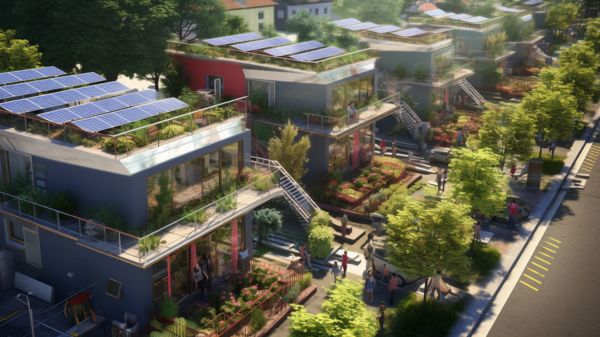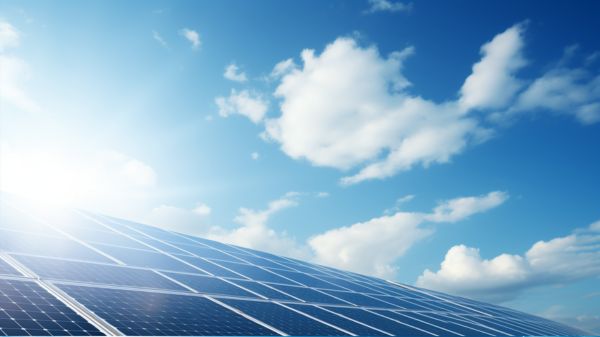We’ve all heard the saying, ‘There’s power in numbers.’ Well, when it comes to renewable energy sources for cities, that saying couldn’t be more true. As a collective, we have the ability to make a significant impact on our planet’s future.
In this article, we’ll explore the top renewable energy sources that cities can tap into. From solar power to wind energy, hydroelectric power to geothermal energy, and biomass energy – we’ll uncover the solutions that can bring us together for a greener tomorrow.
Solar Power
When it comes to powering cities sustainably, solar power is one of the top renewable energy sources we should consider. Solar power has numerous advantages that make it an attractive option for cities seeking a clean and reliable energy source.
Firstly, solar power is abundant and readily available, as the sun’s energy is virtually limitless. Additionally, solar panels have a long lifespan and require minimal maintenance, making them cost-effective in the long run.
However, solar power also has its limitations. It’s dependent on sunlight, so its availability can be affected by weather conditions and geographical location. Furthermore, the initial installation costs of solar power can be high, although they’re decreasing as technology advances and economies of scale are achieved.
Future developments and innovations in solar power hold great promise, such as the use of more efficient solar panels and the integration of energy storage systems. As we continue to invest in solar power, we can create a future where cities are powered sustainably and efficiently.
Wind Energy
Moving on to wind energy, it’s another top renewable energy source that complements solar power in powering sustainable cities. Wind turbine technology has made significant advancements, making it more efficient and cost-effective than ever before.
The potential for wind energy is immense, with strong winds blowing across many parts of the world. According to the Global Wind Energy Council, the global installed wind capacity reached 651 GW by the end of 2020, generating enough electricity to power over 200 million homes.
Wind energy not only reduces greenhouse gas emissions but also creates jobs and stimulates economic growth. Investing in wind energy can help cities achieve their renewable energy goals and contribute to a more sustainable future.
Hydroelectric Power
One of the top renewable energy sources for cities is hydroelectric power. This form of energy harnesses the power of flowing water to generate electricity, making it a sustainable and reliable option.
Hydroelectric power offers several advantages, including its minimal environmental impact. Unlike fossil fuels, hydroelectric power doesn’t produce harmful emissions or contribute to air pollution. Additionally, it doesn’t rely on finite resources, making it a long-term solution for cities seeking to reduce their carbon footprint.
Moreover, hydroelectric power has the potential for future growth. As technology advances, there’s room for improvement in efficiency and cost-effectiveness, making hydroelectric power an increasingly attractive option for cities aiming to transition to clean and sustainable energy sources.
Geothermal Energy
Now let’s delve into geothermal energy, another top renewable energy source for cities, which builds upon the discussion of hydroelectric power. Geothermal energy harnesses the heat generated from the Earth’s core, providing a reliable and sustainable source of power.
However, there are some utilization challenges that need to be overcome. One of the main challenges is the limited availability of suitable geothermal resources in certain areas. Additionally, the initial cost of drilling and setting up geothermal power plants can be high.
Despite these challenges, geothermal energy holds great future potential. With advancements in technology, such as the development of enhanced geothermal systems, we can tap into deeper and previously untapped geothermal resources. Furthermore, ongoing research aims to improve the efficiency of geothermal power plants and reduce their environmental impact.
Biomass Energy
Continuing our exploration of renewable energy sources for cities, let’s now turn our attention to biomass energy, building upon the discussion of geothermal energy.
Biomass refers to organic materials, such as wood, crops, and agricultural residues, that can be used as a source of energy. This renewable resource has a wide range of applications, making it an attractive option for cities looking to transition to cleaner energy sources.
Here are three key points to consider regarding biomass energy:
- Biomass can be converted into various forms of energy, including heat, electricity, and biofuels, providing versatile solutions for different energy needs.
- The use of biomass as an energy source can help reduce greenhouse gas emissions and dependence on fossil fuels, contributing to a cleaner and more sustainable environment.
- However, it’s crucial to carefully manage the environmental impacts associated with biomass production and utilization, such as deforestation, soil degradation, and air pollution.
Conclusion
The top renewable energy sources for cities are like a symphony of nature’s power, each playing its own unique melody. Solar power shines brightly, wind energy dances through the air, hydroelectric power flows with strength, geothermal energy rises from the depths, and biomass energy fuels our future.
Together, these harmonious solutions present a data-driven path towards a greener and more sustainable future for our cities. Let’s embrace these renewable sources and create a symphony of progress.




